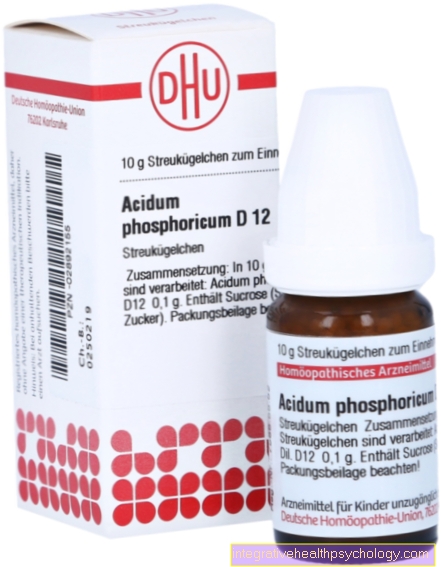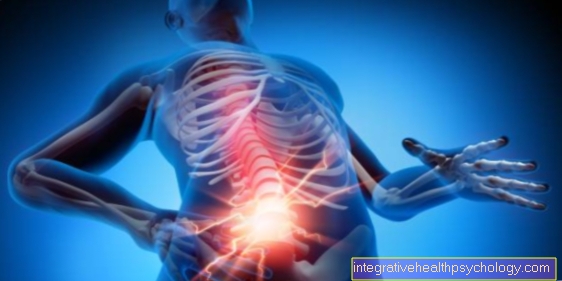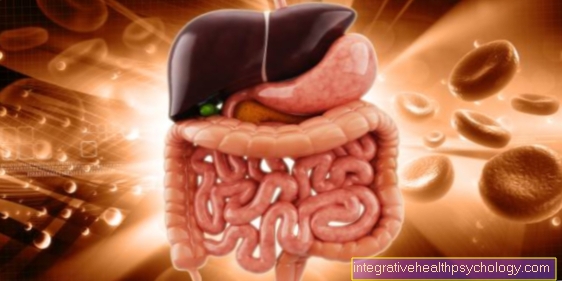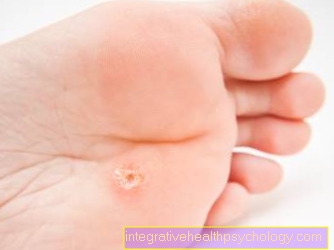Dry pneumonia
introduction
An inflammation of the lung tissue that is mostly due to the colonization of germs is called pneumonia. In many cases, this starts with a characteristic "typical" picture of accompanying symptoms (Symptoms) like fever, chills, slimy (productiveCough and accelerated breathing (Tachypnea) hand in hand.
Some forms of pneumonia are absent from some or all of these typical signs. Then the specialist speaks of atypical pneumonia, which also (because of a lack of fever) "Cold pneumonia", or because of less pronounced, but above all non-slimy (unproductive) Cough is called "dry pneumonia".

overview
Usually, different germs are responsible for atypical, cold, dry pneumonia than for typical pneumonia.
However, the absence of the above symptoms by no means means that atypical pneumonia is more harmless than typical. On the contrary, their absence often leads to a belittlement on the part of the patient and a delayed visit to the doctor. Thus, dry pneumonia can often progress well before it is recognized and treated.
While in the past a predominant part of pneumococcal pneumonia (Streptococcus pneumoniae) was triggered and took a typical course, due to the use of antibiotics, vaccinations, etc., the total number of pneumonia is now lower, but a considerable proportion of 20-40% is of an atypical, dry nature.
Causes of Dry Pneumonia
The spectrum of pathogens that can cause dry pneumonia (atypical pneumonia) is wide.
In addition to various viruses and fungi (Pneumocystis jirovecii) living parasitically in the host cells (intracellular) Bacteria (Coxiella burnetii, Legionella pneumoniae, mycoplasmas, rickettsiae such as Chlamydophila pneumoniae) as the cause of atypical pneumonia.
Unlike typical pneumonia, not just one area of the lungs (one or more lobes, which is why typical pneumonia is also called lobar pneumonia), but the entire lung tissue is affected.
In most cases, the pathogens attack the body's own cells near the basic connective tissue structure of the lungs (Septa). Since this means that the main inflammatory process is not in the alveoli (Alveoli) takes place, but "between the cells" (in Interstitium), atypical pneumonia is also known as interstitial pneumonia.
Read more about virus treatment at the following link: Antiviral drugs
These pathogens cause dry pneumonia
The classic representatives that provoke dry pneumonia include:
- Mycoplasma: bacteria without a cell wall whose only host is humans. This means that they can only be transmitted from person to person. Outbreaks occur more frequently in the autumn and winter months.
- Chlamydia: Bacteria “living” in human cells, which therefore cannot be detected in the patient's blood. There are two strains of chlamydia pathogen that cause respiratory diseases, one of which is transmitted from birds to humans.
- Legionella: These bacteria cavort mainly in stagnant water as well as in air conditioning systems and nebulisers, etc. As a result, they are blown into the air and inhaled by humans, so that they get into the lungs.
- Viruses: Viruses are also among the causes of atypical pneumonia and, unlike bacteria, are usually treated symptomatically and only in rare serious cases with an antiviral.
Symptoms of dry pneumonia
The course of atypical or dry pneumonia depends to a large extent on the causative agent and the patient's immune system. Ultimately, the mortality from this disease also depends on this. In most cases the course is gradual without any real acute phase. Looking back, the sick person is not able to make an exact determination of the onset of the disease.
The symptoms of the disease in dry pneumonia are in most cases not as impressive as they would be in classic pneumonia.
The fever does not rise as high, the urge to cough is much less pronounced and blood tests usually do not show any excessively increased inflammation values. On the other hand, headache predominates as a physical symptom in atypical pneumonia.
The affected person coughs less than in typical pneumonia, with little or no sputum at all. One also speaks of dry cough, which occurs more often at night. Often headaches and aching limbs occur. A general fatigue with reduced drive is typical for adults, for children an increased whining and an increased attachment.
At this point you can read more information on this topic under Pneumonia in babies
An increase in breathing and heart rate is at best moderate. In severe cases or with pre-existing lung damage, it may also cause shortness of breath (Dyspnea) and the lack of oxygen in the tissue causes the mucous membranes and lips to turn blue (cyanosis). Depending on the pathogen, skin rashes or involvement of the brain or intestinal tract with corresponding symptoms are possible.
Treatment with an antibiotic is usually necessary to support the body's immune system in fighting the pathogens. Even if the disease can be treated well with antibiotics, people today still die from pneumonia. The mortality of patients increases with age, regardless of whether they are typical or atypical pneumonia.
Pneumonia caused by Legionella has the highest mortality among the causative agents of atypical pneumonia.
Read more on this topic at: Pneumonia
Without a fever
Usually there is no rise in body temperature (fever) or only slightly pronounced (<39 ° C). Chills as a result of the fever only occur in a few patients.
It is precisely this fact that often leads to a doctor being consulted a few weeks after the onset of the illness.
Read more about pneumonia without a fever here
That's how contagious dry pneumonia is
The risk of infection depends to a large extent on the "aggressiveness" of the pathogen and on the patient's immune system.
Since the pathogens for pneumonia in the vast majority of cases have to get into the lungs via the airways in order to be able to trigger pneumonia, coughing represents a possibility of transmission of the pathogens. Since the coughing stimulus in dry pneumonia is generally less pronounced than with typical pneumonia, the risk of infection is lower.
Diagnosis of dry pneumonia
What do you see in the x-ray?
On the x-ray, atypical or dry pneumonia differs from typical pneumonia due to the diffuse distribution of the inflammatory infiltrate.
The water and mucus deposits cannot be clearly limited to one lobe of the lung, but exist across borders. One speaks of interstitial pneumonia, while typical pneumonia is the most likely to find signs of lobar pneumonia.
The whole lungs appear whiter in the X-ray image and there are hardly any black areas within the lungs that would indicate normal, non-inflamed lung tissue.
At this point, read our next article below: X-ray of the chest
What do you see in the CT?
The CT usually confirms what can already be seen in the X-ray image.
However, computed tomography is only indicated if the X-ray image does not provide any clear findings, as the CT would otherwise represent an unnecessarily high radiation exposure for the patient.
However, with its three-dimensional viewing option, CT offers the option of recognizing structures or changes that would be covered by the inflammatory infiltrate in the X-ray image.
By default, however, no CT should be performed, but rather the X-ray image should always be preferred in order to keep the radiation exposure as low as possible. However, if abscesses or empyemas are discovered, this could provide clues to other pathogens that would then have to be treated differently therapeutically.
Would you like to learn more about computed tomography of the lungs? Read our next article on this: CT of the lungs
How does the blood count change with dry pneumonia?
Particularly interesting is the change in the blood count, which is only slightly indicative of inflammation.
While in typical pneumonia there is a sharp increase in leukocytes and the inflammation markers C-reactive protein and calcitonin, these values are by far not as high in atypical pneumonia.
The values can still be in the upper range of the norm value, but mostly exceed it. Despite all this, the laboratory values do not suggest that it is pneumonia that affects the entire lungs. Even if it is not a direct laboratory parameter, it is a clue that is much less increased in atypical pneumonia than in typical pneumonia.
Therapy for dry pneumonia
The main pillar of the treatment of dry pneumonia is causal antibiotic therapy.
Usually, before or without a clear identification of the pathogen, an appropriate antibiotic is given, either via the vein as an infusion (intravenous) or in tablet form (per os) administered. Only if the patient's situation does not improve or if the pathogen becomes known is it then possibly changed or adapted to the detected pathogen after the pathogen is detected.
In addition to causal therapy, symptoms are also treated depending on their severity. Thus, fluid supply (in extreme cases also via infusion) and, in the case of respiratory distress, oxygen supply via mask or nasogastric tube complete the treatment.
People who suffer from atypical pneumonia are not obliged to go to bed, on the contrary, with a gentle posture, light physical activity in the fresh air (such as short walks) and possibly breathing exercises should be beneficial for recovery.
For more information, read on here: The therapy of pneumonia.
Duration of dry pneumonia
In general, it can be assumed that dry pneumonia takes a little longer to be treated than typical pneumonia. This is not least due to the fact that it usually takes longer before dry pneumonia is recognized as such.
It differs from typical pneumonia in that the typical signs such as high fever, increased respiratory rate and sputum when coughing are missing. In addition, the antibiotics that are used in the treatment of dry or atypical pneumonia also differ, since the spectrum of causative germs is also different.
In addition, factors such as the patient's immune status, age, and physical fitness also play another important role when it comes to how long the pneumonia lasts. In the case of atypical pneumonia, however, one can roughly assume a duration of two to three weeks, while with typical pneumonia it is more likely only one to two weeks.
However, you should take care of yourself in any case and follow the doctor's instructions, otherwise pneumonia can be spread. This can even be life-threatening.
Prophylaxis of dry pneumonia
While there are currently no vaccinations against dry cough (atypical pneumonia), there are still some behaviors that can significantly reduce the risk of developing dry pneumonia.
In particular, serious courses almost exclusively affect people with previous illnesses or immunodeficiency. These difficult processes can be counteracted by a healthy lifestyle. A balanced diet and physical exercise play a role here.
In addition, not consuming tobacco prevents previous damage to the lungs, as well as abstinence from alcohol prevents a weakening of the immune system.
Prognosis of dry pneumonia
It is difficult to make generalized statements about the prognosis for dry pneumonia. Depending on the type of pathogen, age and immune competence of the patient, accompanying illnesses and duration of illness up to the start of therapy, the spectrum ranges from complication-free healing within days, to lengthy, complicated processes and even death.
While in the vast majority of cases a rapid recovery is possible through early antibiotic therapy, the mortality rate is, for example, with Legionella pneumonia (mortality) at about 10%.





























